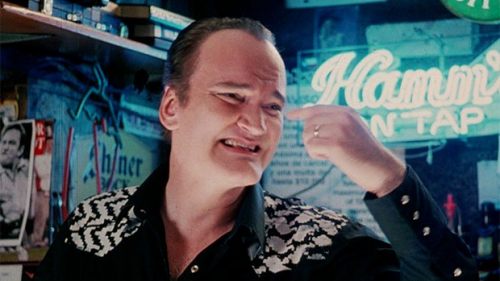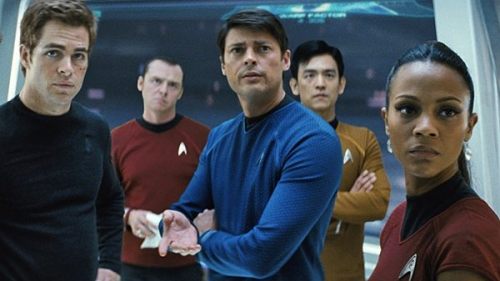INGLOURIOUS BASTERDS And The Narrative Of Cinematic Violence
Early last year, amidst the controversy surrounding Clint Eastwood’s American Sniper, actor Seth Rogen tweeted that the film reminded him of the one being viewed by the Nazis in the third act of Inglourious Basterds. People on the American political right responded to the sentiment with as much ire as those on left did to Eastwood’s film, and at the center of it all were two conflicting narratives on the narrative itself. Each politically charged and existing at opposite ends of whatever spectrum houses the extremes of ‘truth’ and ‘propaganda’. The American war film will, by its very nature, always be a topic of conversation with regards to politics and perspective, and Basterds is no exception, however what separates it is not only an awareness of this dichotomy, but its stylization as an American Western.
The Western is a fascinating genre. It’s uniquely American in origin, regardless of where it ends up, but despite its depths and breaths, the iconography of the Western in the minds of the general public tends to be about America’s heroic self-image. It’s the war film minus the contemporary political complications, embodied by the likes of John Wayne. The square-jawed cowboy represents American masculinity and nationalism every bit as much as the American soldier, and he exists within the realm of nostalgia. It’s a genre that draws from time periods before cinema itself, giving it the ability to exist as something entirely separate from America’s actual history, while simultaneously harkening back to the days of its origins. The Western that exists in the mainstream consciousness is inherently revisionist, despite its apolitical appearance, and Quentin Tarantino is acutely aware of that fact. He wants to draw our attention to it, though he’s not necessarily indicting it either. Revisionism can certainly be historical, reaching far back into history (both literal and cinematic) but for Tarantino, it can be as simple as scrutinizing and re-contextualizing the way modern audiences absorb cinematic violence, especially when it comes to his own works.
To see a distilled version of Tarantino using the Western to draw attention to the nature of revisionist narratives, one has to look no further than his Basterds follow-up, Django Unchained. In it, he takes America’s most revered and magnetic historical icon, the cowboy, and combines it with the original sin America keeps trying to sweep under the rug, the slave. He uses an enticing aesthetic to draw the audience’s eye elsewhere, though while this approach combines the attractive and the unattractive from the standpoint of what general audiences wish to be reminded of, his approach in Inglourious Basterds combines the Western’s aesthetic with not only his own brand of ultra-violence, but with the violent exploitation of Nazis, one of history’s greatest villains. It’s similar in methodology, though when one considers the specifics, the effect is the complete opposite. It’s the romanticization of violence, given a sort of free pass because of the subject matter. It uses music cues, camera movements, and even set pieces (from saloons to bridges) that are familiar to minds of Western audiences, making the status quo of the narrative a generally un-challenging one, at least when compared to Django and The Hateful Eight, but that’s only the surface of the narrative. We all hate Nazis, and seeing them perish painfully can be made a fun experience, no questions asked! Only Tarantino is most definitely asking the questions, no more obviously than during the aforementioned theatre scenes.
Hitler and his Reich gather to watch Nation’s Pride, the story of Private First Class Fredrick Zoller, in which Zoller is the star. While Zoller is somewhat uncomfortable watching the events unfold, having been privy to the actual violence himself, the Nazis laugh and cheer gleefully at every instance of mindless bloodshed that suits their narrative. Correct-side-of-history aside, there’s little technical difference in the enjoyment of the violence seen in Basterds, and it’s made all the more enjoyable thanks to the film’s visual finesse, which (barring his most recent film) is almost unique to this entry in his filmography. Tarantino appears as a fallen Nazi soldier in Basterds and a falling American soldier in Nation’s Pride, becoming the subject of cinematic violence as seen by both layers of audiences. An American soldier falls through one of the windows in the Zoller films the same way a Nazi theatre-goer falls through the window of the flaming theatre just moments later. We may as well be Tarantino’s Hitler, enjoying the mutilation of bodies we hate at the hands of heroes we worship, the only thing separating us is history as we see it. However, that’s not the only statement about our enjoyment of cinematic violence being made.
Before Nation’s Pride cuts to Shoshanna’s own footage, Zoller (playing Zoller) asks if anyone amongst the American soldiers want to send a message to Germany, and he does so while addressing the audience. Shoshanna responds. She has a message for the German Reich, and she delivers it by breaking the fourth wall as well. It harkens back to the very first Western, The Great Train Robbery, which ends with a bandit shooting ‘the audience’, getting rid of us like a loose end for having witnessed something we shouldn’t have. Shoshanna puts a similar responsibility on our shoulders. We’re the final ingredient in cinematic violence. It exists to serve us, but its creation wouldn’t be possible without us interpreting it and closing the loop, giving the narrative meaning in our heads based on the pre-existing narratives we bring into the theatre. The juxtaposition of Zoller and Shoshanna is only a juxtaposition in terms of historical context. On a purely technical level, it’s the exact same shot – although that’s perhaps the most important distinction. We may as well be Tarantino’s Nazis, but the fact that we aren’t makes all the difference, and the film’s biggest advantage in that vein is providing separation. Zoller doesn’t have that luxury, which is why he exits the theatre and moves into a different realm entirely: the projection booth, where the images originate from.
Pixar’s Inside Out features a command center similar to a movie theatre, wherein the ‘screen’ is filled up by projected memories. It’s a metaphor that works because the projected visual elements, originate from both emotional and factual place, one that exists outside the images themselves. Shoshanna’s projection booth, like most projection booths, is located both above and behind the audience, as if it were at the back of their minds. It’s here, outside the eventual home of the projected images, that violence itself originates. During the gunshots heard in the film, the real life Zoller and Soshana shoot and kill each other. There’s beauty to how this scene is shot as time itself expands, allowing their deaths to hold our attention as opposed to passing us by like every other in the film, but any enjoyment in this moment is not from the violence itself. The pain it causes is mapped out on every inch of their faces, instead of being mere explosions of blood. In fact, as Shoshanna is shot, the fictional Zoller is visible on screen right over her shoulder through the projection window. It’s the same kind of violence, perpetrated by the exact same shooter, but its presentation (and its context within the story) is completely different. There’s so much separation between us and Nation’s Pride, the layer of the screen between us and Basterds as well as the layer of the screen within the film, that even the violence against the American villains – the heroes of this film – becomes ridiculous, as it’s approached from the perspective of the supposed idiotic Nazi viewers. It’s a cheap propaganda product, but the actual result of their violence (in this case the Nazi Zoller shooting a Jewish woman) is right up in our faces.
Seconds later however, we’re following the Basterds, as they punch people with guns.
Violence itself is a fluid thing. It’s all about presentation. For someone like Tarantino, who’s been accused of violent excess to the point of real-world influence, presentation is a big deal. Does cinematic violence cause real-world violence? Generally speaking, no. The violence in Nation’s Pride isn’t likely to cause anyone in that audience to be any more violent than they already are. However, the real violence taking place just out of view, in the projection booth, is something they ignore. Furthermore, the violence on screen is a very direct extension of the violence in the booth. One is the actual Zoller, the other is the image of him, crafted from the now mythical Zoller and how he’s perceived in the minds of the people. We’re so ready to condemn Tarantino and the likes for creating violent images that we don’t address the images that already exist in our collective consciousness, nor the real world violence happening just off-screen. Tarantino is no more responsible for real-world violence than Nation’s Pride is for the death of Shoshanna.
Is the Western inherently revisionist? That’s a hard claim to support, but the archetypal image of the Western might be. It is, however, a reflection of America’s own revisionism. Of seeing gunslingers as folk heroes and of seeing Natives as savages, cinematic ideas that seep in from the outside. As the cinema burns down in Inglourious Basterds, it’s the locking of the doors from the outside that seals the audience’s fate. It’s the Basterds shooting them from above, and their bullets and their bombs, that do the real damage. The screen may be ablaze as Shoshanna laughs at the audience’s demise, her ghostly image projected on the theatre’s smoky remnants, but what truly kills them comes from outside the cinema. Her film was just what caused the hysteria, setting off a panic that would’ve come to pass anyway.



